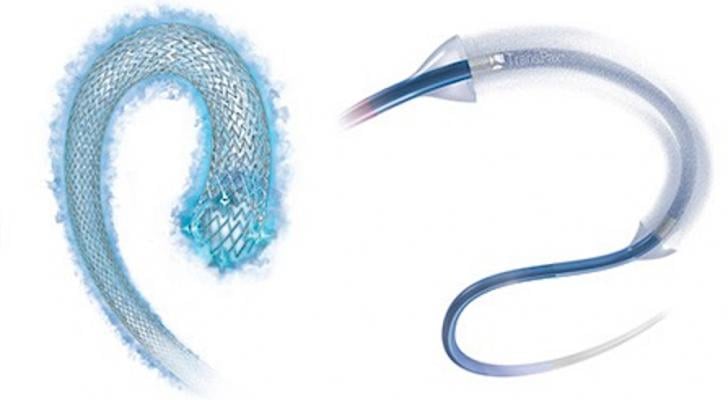
November 6, 2019 – Boston Scientific announced positive data for two of its devices within the peripheral drug-eluting product portfolio during separate late-breaking clinical trial presentations at Vascular Interventional Advances (VIVA) meeting in Las Vegas. Data presented included a 12-month interim analysis from the RANGER II SFA Trial of the Ranger Drug-coated Balloon (DCB), and the 24-month results from the IMPERIAL Trial of the Eluvia Drug-eluting Vascular Stent (DES). Both devices exhibited the highest 24-month primary patency reported to date for the treatment of femoropopliteal disease in a U.S. pivotal trial with a DCB or DES.[1]
The RANGER II SFA study evaluated the safety and effectiveness of the Ranger DCB, which has a low drug dose density of paclitaxel, versus standard percutaneous transluminal angioplasty (PTA) for the treatment of patients with peripheral artery disease (PAD) in the superficial femoral artery (SFA) and proximal popliteal artery (PPA).
In the trial, the Ranger DCB exhibited a primary patency rate — a measure of the target vessel remaining unobstructed at 12 months — of 89.2% compared to 72.9% percent in patients treated with standard PTA (p=0.0022), by Kaplan Meier estimate. Additional key findings from the trial include:
• Patients treated with the Ranger DCB had a significantly lower target lesion revascularization (TLR) rate of 6%, in contrast to 17.9% observed with standard PTA (p=0.0018), substantially reducing the patient’s need for repeat procedures at 12 months;
• No difference in all-cause mortality at 12 months with a 2.3% rate for the patients treated with Ranger DCB vs. 2.5% in patients treated with standard PTA (p>.99);
• Data from the pharmacokinetics (PK) sub-study showed that 11 of 12 patients with an average lesion length of 154.2 mm had unmeasurable paclitaxel levels in venous plasma approximately one hour after DCB deployment and removal.
“These excellent clinical data coupled with the ease of deliverability of the Ranger DCB are reassuring for physicians as we evaluate the most appropriate therapies based on individual patient needs,” said Ravish Sachar, M.D., University of North Carolina - Rex Hospital physician-in-chief for heart and vascular services and principal investigator of the RANGER II SFA trial. “The high primary patency rate as well as the significantly lower TLR rate, which reduces the need for repeat procedures, are very encouraging.”
Eluvia Stent vs. Zilver PTX
Also presented at the meeting was a 24-month analysis of data from the IMPERIAL Trial, which evaluated the Eluvia stent versus the Zilver PTX Drug-eluting Peripheral Stent for the treatment of patients with symptomatic PAD that had SFA and PPA lesions up to 140 mm in length. The Eluvia stent utilizes a drug-polymer combination and offers controlled delivery and sustained release of the lowest dose of paclitaxel of any peripheral drug-eluting device. In the study, the Eluvia stent exhibited a primary patency rate of 83% versus 77.1% with Zilver PTX, by Kaplan Meier estimate, the highest 24-month primary patency reported to date for the treatment of femoropopliteal disease in a U.S. pivotal trial with a DCB or DES.[1] The analysis also confirmed:
• Statistically significant lower clinically-driven TLR rate of 12.7% for patients treated with the Eluvia stent, in contrast to 20.1% observed within the Zilver PTX cohort (p=0.0495), thus reducing the need for repeat procedures at 24 months;
• A low all-cause mortality rate of 7.1% for the Eluvia stent and 8.3% for those treated with the Zilver PTX (p=0.6649), which is within range expected for symptomatic peripheral arterial disease.[2]
“We are very pleased with the safety and efficacy demonstrated by the Ranger DCB and the Eluvia stent, both of which showed exceptional durability while preventing repeat TLRs in 66% and 40 percent of treated patients, respectively,” said Ian Meredith, M.D., executive vice president and global chief medical officer, Boston Scientific. “The excellent outcomes presented today underscore our commitment to physicians and their patients with PAD. We continue to drive innovation in the drug-eluting vascular space and these results add to the growing body of evidence supporting our therapy options for the treatment of this challenging disease.”
The RANGER DCB gained European CE mark in 2014 and the company submitted for U.S. Food and Drug Administration (FDA) approval of the device earlier this year. The combination of the RANGER DCB as well as the Eluvia stent positions Boston Scientific as the only company to have both a DES and a DCB for the treatment of PAD in their portfolio.
In the U.S., the Ranger DCB is an investigational device and is not available for sale.
For more information: www.bostonscientific.com
Find information on all the VIVA 2019 Late-breaking Clinical Trials
References:


 April 24, 2024
April 24, 2024 








